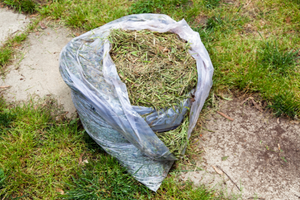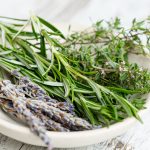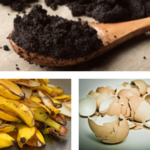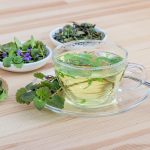In this article, we take a look at how to make the best homemade fertilizer for herbs. When we look at how to make fertilizer for herbs there are simple or complex methods. Making DIY fertilizers for herbs need not scare you. You will see how to make homemade natural fertilizer simply and quickly.
Making a DIY fertilizer for herbs is fun and saves money. In addition to being cost-effective, the DIY fertilizers you can make are active – this means that the microbes in the fertilizers are in a state of growth -they have not been sitting in a bottle on the shelf for 6 months.
Homemade fertilizer is most likely organic too which is much better than a synthetic fertilizer too as it will nourish both the plant and soil.
Homemade liquid fertilizer for herbs
My favorite method to make homemade natural fertilizer is an old and simple recipe. I use some zip ties to make a bag out of a shade cloth. This bag fits in a small 10-gallon drum. I then pour aged cow, horse/rabbit, sheep, and chicken manure into the bag in roughly equal parts. Don’t use fresh manure as this can be a bit too nitrogen-rich.
Why so many types of manure?
In nature, there are many species of animals that create manure in an ecosystem. Birds, ruminants (e.g. cows, sheep), and animals such as rabbits and horses have different ways of digesting plant matter.
When we make a DIY organic fertilizer for herbs we want to mimic nature as much as possible. If we mix all of these types of manure we are simulating the sort of dung that would fall on the fields in nature. If you cannot get all types of manure but can get one type, use that. It will still be good.
The manure tea bag
Zip tie the bag closed, put it in the drum, and fill the drum with rainwater. I typically leave this for two weeks. Every now and then you can open the drum and squeeze the bag a bit to circulate the water. It can develop quite a strong smell but this is how we make DIY organic fertilizer for herbs. If it’s organic it smells. Rule of nature.

Filtering the liquid DIY fertilizer for herbs
I typically pump the DIY liquid fertilizer into my irrigation system. I have a pump that turns on with the irrigation pump and sends the fertilizer mixed with irrigation water out through the microjet sprinklers. Hence I filter the liquid DIY organic fertilizer through an old pillowcase. This provides a solution that looks like dark tea.
A well-filtered homemade natural fertilizer can be diluted 1/10 in water and applied with a watering can. If you sprinkle it on the leaves of plants, many plants like this. Alternatively, drench the roots. Your plants will grow very fast.
I find that celeriac, parsley, savory, marjoram, and oregano particularly enjoy this liquid homemade natural fertilizer. If you put this on mint it will explode out of the pot. Mint is a heavy feeder and loves the slightly acidic nature of this natural organic fertilizer.
Ash from your fireplace
An enhancement to making the above manure tea bag recipe is to use a bit of wood ash in your mix as well. You mix the same recipe as above, except that you now add equal portions of the three manures and then a part wood ash. You can play with the ratios as you see fit.
The advantage of adding wood ash to your DIY fertilizer for herbs is that it contains significant amounts of potassium, phosphate, magnesium, and calcium. It is also a rich source of trace elements. Combining wood ash into this homemade organic mix gives you an excellent supplemental homemade fertilizer.
Alternatives to manure-based fertilizer
Fish and seaweed make great fertilizer for herbs too. Homemade fish emulsion fertilizer takes longer to make as the fish need to rot first. An easy shortcut is to use your aquarium water. You may even have things from your kitchen you can use such as coffee grounds, banana peels, and eggshells.
Homemade fish emulsion fertilizer for herbs
Fish fertilizers for herbs stink to high heaven but they are good fertilizers. It is relatively easy to source fish – typically if you can find fish used for bait in sea fishing, these are the best for making fertilizers. Any oily fish will do, although you can use pretty much any fish, the oilier it is the better. Ask the fishmonger if they have fish skeletons and heads for sale – these are a rich source of amazing minerals for your plants.
Your fish emulsion fertilizer also needs molasses. Molasses is the product left over after sugar has been extracted from cane juice. There are many types of molasses, try to buy molasses that does not have sulfur added.
Depending on the amount of sugar that has been removed, you will get different grades of molasses. The less sugar the molasses has in it, the more minerals it contains. In this regard, if you can choose between a high test (high sugar) and a blackstrap molasses, choose the blackstrap.
Molasses is good for microbes and microbes are good for soil. So molasses is good to add to fertilizer.
How to make a fish emulsion
My method for making fish emulsion is quite simple. In a 5 gallon pail, I place two cups of fertile soil with compost (this is rich in beneficial soil microbes). Into this bucket place a pound of oily fish. Cut the fish up into small pieces. Add a pound of molasses and two gallons of water. I like to add the juice of two lemons at this point.
Stir the mixture and then place a loosely fitting lid over the pail. Do not put the lid on firmly – you want gasses to move in and out. You can open the bucket every second day and give it a stir. The smell will not be quite as bad as you would expect. This is however definitely not something you can make inside your apartment.
After two weeks, give the mixture a good stir. I have an electric drill with a paddle paint mixer. If you make a hole in the lid of the bucket and put the shaft of the mixer through, then you can put the lid back on the bucket and connect the drill.
It is better not to try and mix fish fertilizer without a cover – the stuff splatters and one drop that lands on your face will make you think you have a dead fish in your nose for a day.
You can strain this emulsion through an old pillowcase or sieve and then use the mixture.
How to use fish emulsion fertilizer on herbs
Fish emulsion is hot – in other words, it is rich in available nitrogen – so you need to dilute it. I typically work on a dilution of 1 cup of fish fertilizer in a 5-gallon bucket of water to make a fertilizer tea.
Remember, unlike using fish fertilizer on houseplants, you do not want to foliar feed your herbs. You will end up with fish-flavored herbs. Just not a good thing, unless it’s on your catnip for your cat.
You can scoop a cup or two of the diluted fertilizer mix and pour it around the base of the herbs. The idea is to drain this onto the roots so that the roots are well inoculated with beneficial microbes. In addition to the microbes, there is an abundance of nitrogen, phosphate, calcium, and a little iodine in fish fertilizer. These are all good things.
Seaweed fertilizer for herbs
You can adapt the above recipe by adding a bit of seaweed to your mix and fermenting it as per the above instructions. I collect kelp that washes up on the beach after a storm. If you are not able to collect your own seaweed, you should be able to buy an assortment of inexpensive seaweed from a shop in Chinatown or health shop or even online. You will need 3-5 oz of dry seaweed for this recipe.
Soup seaweed is the most cost-effective. This is also conveniently cut up into little pieces. Hydrate a bit of seaweed, or if you have fresh seaweed, rinse it in a bucket of freshwater to get rid of salt.
If possible, cut the seaweed even finer. Place seaweed in the bucket, along with the fish and molasses, and process it the same way you did the previous fish recipe. For some reason, adding seaweed makes this smell even more vile and makes your plants even happier. No pain, no gain.
Compost tea
This is a great quick and easy fertilizer that your herbs will love. You only need 2 ingredients: compost and water.
Fill a bucket with water. Let it sit for 24 hours for any chlorine to evaporate. Then add your compost. Use a stick to mix it and get some aeration in there for those beneficial bacteria and microbes. Then let it sit for 24-48 hours. Give it a mix each morning and night then pour into a watering can to water your herbs. You can filter it if you like but it’s not essential. Easy peasy!

Grass Clippings tea
Grass clippings are high in Nitrogen which is an essential element your herbs need to keep their leaves green. To make a grass clippings tea add your grass clippings to a bucket and fill it with water. Let it marinate for 1-2 days. Strain the water into a watering can and use this liquid fertilizer to water your herbs.
Your herbs will love these natural homemade organic fertilizer tea recipes.
They are suitable for your vegetable garden too as well as indoor plants.
Homemade plant food is so cheap and simple. They are so much better than chemical fertilizers. Especially since we are talking about edible plants. I certainly don’t want to be ingesting anything synthetic or feeding it to be kids when it can be avoided.
However, if you live in an urban area or apartment and don’t want to deal with manure or the stench of rotting fish then you may prefer using something from your kitchen instead. Check out this article for how you can use coffee grounds, banana peel, and eggshells as fertilizer for your herbs.
Now, I would love to hear from you. Let me know in the comments if you make this manure tea bag or what your favorite homemade fertilizer recipe is for your herbs.
Affiliate Disclosure: As an Amazon Associate we earn from qualifying purchases. Some links may be affiliate links. We may get paid if you buy something or take an action after clicking one of these links.





Pingback:Best Organic Fertilizer for herbs - Herb Growing Guide
Pingback:The ultimate herb gardening for beginners guide - Herb Growing Guide
Pingback:How to grow herbs indoors without sunlight - Herb Growing Guide
Pingback:How to make fertilizer from kitchen waste? - Herb Growing Guide